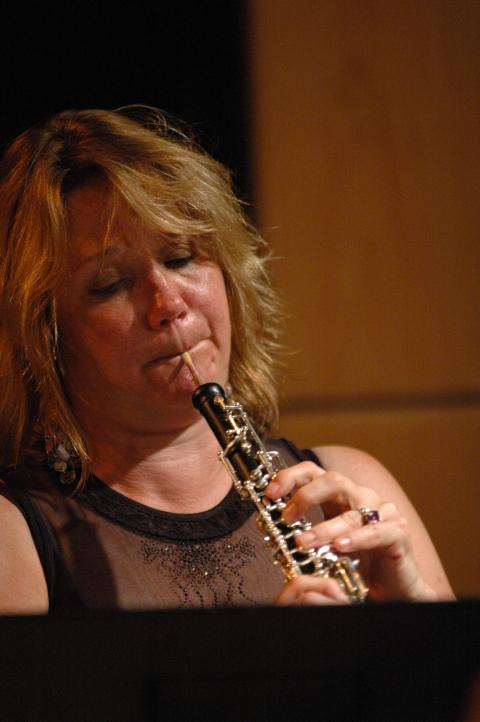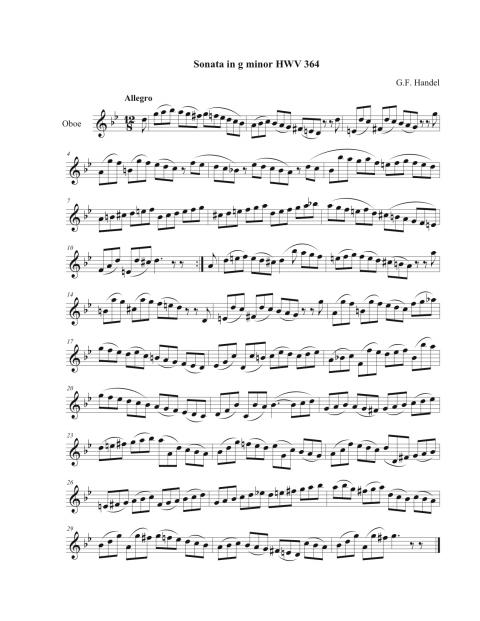The Woodshed: The Logistics of Circular Breathing

Professor Barbara LaFitte is the principal oboist for the Boston Ballet Orchestra and plays English horn with the Boston Pops Esplanade Orchestra. She played on the Providencia CD by Danilo Pérez and on the Boston Modern Orchestra Project’s recording of Steven Mackey’s Dreamhouse. Both received Grammy nominations.
Players of various wind instruments use the circular breathing technique to play long, sustained notes without interruption. Musicians of diverse backgrounds who play the shawm, Australian didgeridoo, Sardinian launeddas, traditional Asian oboes and flutes, and more have employed the technique. Jazz players such as saxophonist Rahsaan Roland Kirk, trumpeter Wynton Marsalis, and Trombone Shorty, and such classical musicians as saxophonist Eugene Rousseau, clarinetist Martin Fröst, and oboist Marcel Tabuteau have also used the method.
Saxophonist Geovanny Escalante holds the world record for continuous playing for 90 minutes. He broke the previous record set by Kenny G who held a note for 45 minutes on his soprano saxophone.
But, after taking an informal survey of my colleagues, I learned that most don't use the technique. In Europe, though, circular breathing is a common-and sometimes required-practice. Former oboist Jonathan McPhee, the conductor of the Boston Ballet Orchestra, learned circular breathing as a matter of course in the United Kingdom. He was surprised that the method is not commonly taught in the United States.
I learned the technique while studying with the late great Lou Rosenblatt, English horn soloist with the Philadelphia Orchestra from 1959 to 1995. He was a student of oboe icon Marcel Tabuteau, who taught Rosenblatt the concepts that he passed on to me.
I remember being at Rosenblatt's home as he taught circular breathing. Both of us stood in front of a mirror holding a glass of water. He put water in his mouth, held it in his cheeks, then pushed it out by pressing his cheeks with his index fingers, creating a fountain of water. Next we used our cheek muscles instead of our fingers. When applying the technique on the oboe (filling the cheeks with air instead of water), the cheek muscles can act on their own as bellows.
Years later, I moved to Boston and joined Emmanuel Music. The group plays the Bach cantatas as a part of Sunday church services. Playing Bach inspired me to work on circular breathing so that the sinfonias and arias would become stress free. After 30 years of Bach, I thank Rosenblatt for teaching me this valuable technique.
How It's Done
First, we need to discard some preconceived notions: (1) you can't breathe through your nose when playing; (2) you can't puff out your cheeks when playing; and (3) You can't close your throat when playing.
Our primary breathing sources are the nose and mouth. We can close off either one and use the other as a source for breath, or we can use both simultaneously or alternately. The following exercises will help you learn the technique.
Exercise 1
Sit calmly, close your mouth, and breathe through your nose. Notice that your tongue rises up to close off your nasal cavity as when you say the letters N or G. Yet you can still breathe with your tongue in that position. The back of the tongue is up, the front of it is down by the bottom teeth.
Exercise 2
Still calm, puff out your cheeks and breathe through your nose. You can even hum while doing this.
Exercise 3
The next step of this process is known as "making raspberries." Try this with the mouth and cheeks only by puffing your cheeks out with air and make a buzzing noise with your lips.
Now, put it all together: (1) fill your cheeks with air (2) breathe normally through your nose; (3) place the index fingers near your cheeks; (4) inhale, exhale, relax, inhale, exhale, then push the cheeks while inhaling; (5) try this a few times until it becomes comfortable.
Next, expell the air from your cheeks without your fingers by making the "raspberry" sound. After you get the feel for this, try it while inhaling or exhaling.
Once you understand the logisitcs of circular breathing, they can be applied to playing every wind instrument. At first you may encounter frustration reconnecting the air passages or transitioning back and forth between using the air in the cheeks and normal breath support. It may also be difficult to keep the pitch stable
When reconnecting the air, it helps to think of pushing the tongue forward, as if you are saying "gah." Your tongue quickly comes down when you make the sound, and the nasal passage reconnects to the lung passage. When you hesitate, there is a break in the sound. It takes some effort to avoid the break. Don't be discouraged by the silence, work through it and the sound will connect.
The pitch will be stabilized by your embouchure. Usually the pitch dips when you reconnect the air columns. Try tightening the embouchure momentarily to keep the pitch stable. It requires flexibility, but it's possible. Practice doing long-tone warm ups with circular breathing and keeping the pitch steady.
When to Use Circular Breathing
Jazz players can employ circular breathing as dictated by the melodies they play and intuitively during their improvisations. I play the oboe in classical settings and find that circular breathing is useful for long technical passages, cadences, and trills, tutti fermatas, and long tutti passages. It is easier to use in legato or slurred passages. On the oboe or saxophone, try using it on the "long fingered" notes in the staff; D, E?, or C?. Executing lower notes is much more difficult given the embouchure changes that affect these notes. Higher notes tend to be less stable, but with a strong embouchure, you can pull it off.
Some people avoid circular breathing because of audience comfort: Many audience members like to breathe with the music; and if performers look tense as they play, the audience gets tense. One secret is to try to look relaxed. Another is to use the technique just at the end of a phrase to prevent a note from dying out prematurely.
The two musical examples help when practicing the technique. Example 1 is an exercise from Technique of the Saxophone, Volume 3 by Joe Viola. Play the entire piece with circular breathing. Example 2, from a Handel sonata, has prompted some to declare that it must have been intended to be played on violin because there are so few places to breathe. The piece becomes easier with circular breathing.
With patience and practice, you can apply this useful technique to any style of music that you play.






